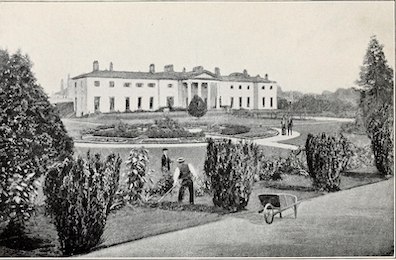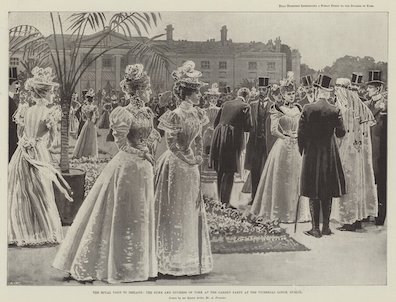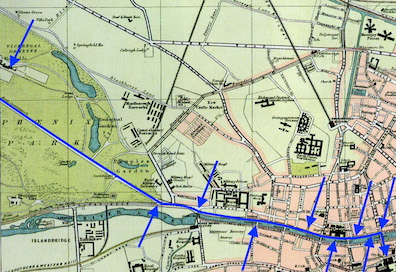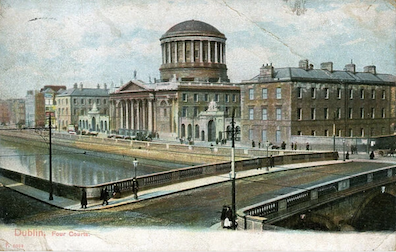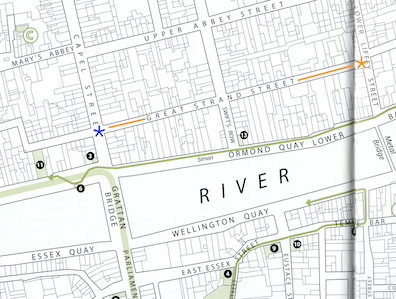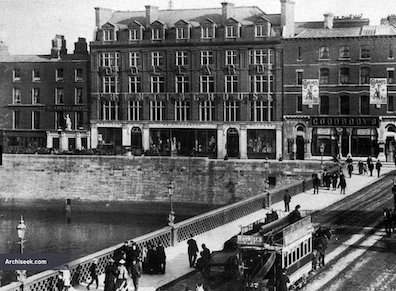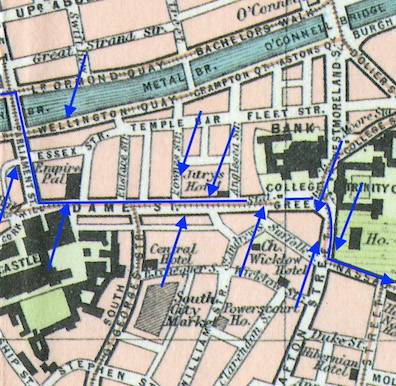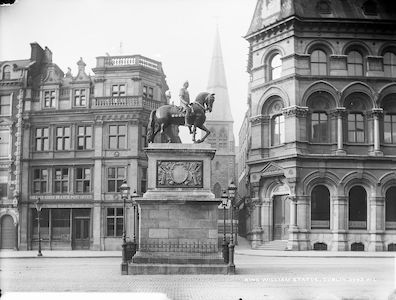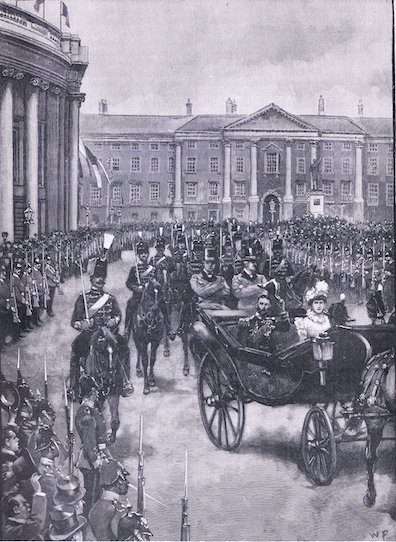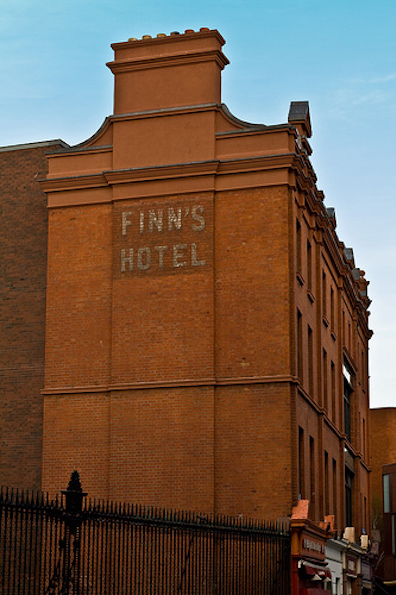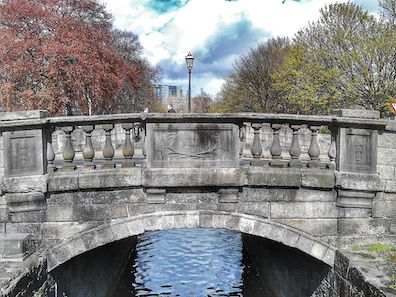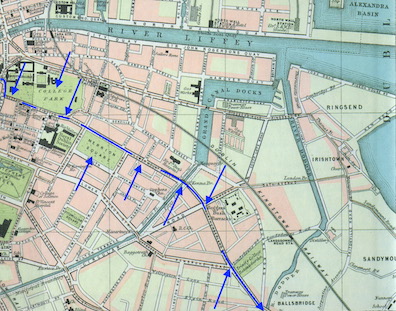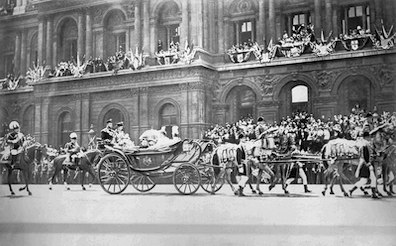Viceregal cavalcade , from Joyce Project
Final space-time. Section 19 of Wandering Rocks traces the route of “the viceregal cavalcade” glimpsed briefly in sections 9 and 11––a parade of open carriages that leaves Phoenix Park on the western edge of Dublin, drives along the northern quays, crosses the Liffey at the Grattan Bridge, and follows a succession of streets in the southeastern quadrant of Dublin on its way to the suburb of Ballsbridge, where the viceroy will “inaugurate the Mirus bazaar in aid of funds for Mercer’s hospital.” The action takes up most of the 3-4 PM hour, overlapping all previous sections of the chapter. There are no interpolations, but the cavalcade passes by many people featured in earlier sections, emphasizing the temporal inclusiveness of this one. Although the purpose of the ceremonial procession is to let Dubliners honor their ruler, not many of the people who see the viceroy show much admiration. Their distinctly tepid greeting gives a heretofore unrecognized meaning to the Homeric motif of crashing, crushing rocks.
Britain’s monarch and its government were represented in Ireland by a Viceroy, also known as the Lord Lieutenant, or the Lieutenant General and General Governor, of Ireland. In 1904 this man was “William Humble [Ward], [the second] earl of Dudley.” Dudley, his wife, and several noble attendants leave “after luncheon from the viceregal lodge,” on the north side of Phoenix Park, in two carriages that take them “past Kingsbridge along the northern quays.” Reflecting the usual expectations about such regal parades, the narrative notes––sounding rather like a respectful newspaper account––that “The viceroy was most cordially greeted on his way through the metropolis.” This claim begins to feel ironic, however, as cordial greetings are massively outweighed by dutifulness, indifference, distraction, incomprehension, and veiled hostility.
At “the lower gate of Phoenix park” (the one at the park’s eastern end), the viceroy is “saluted by obsequious policemen”––hardly exemplars of adoration. At “Bloody bridge,” the old name for Barrack Bridge (which today is the Rory O’Moore Bridge), Tom Kernan, who is on the other side of the river, greets the procession “vainly from afar.” Since Kernan is only nominally Catholic and has acted the part of a west Briton in section 12, his respect may be supposed more heartfelt than the policemen’s. But, like many words in Wandering Rocks, the adverb “vainly” introduces an ambiguity. Kernan’s efforts to get the nobles’ attention are futile, but in section 12 he congratulated himself on his expensive-looking jacket, suggesting that now he may want to draw attention to himself. A little farther east, the viceroy goes “unsaluted by Mr Dudley White” as this lawyer, encountered nowhere else in the novel, mulls the more important business of how to get from the Four Courts to Phibsborough. White is standing “Between Queen’s and Whitworth bridges” on “Arran quay outside Mrs M. E. White’s, the pawnbroker’s, at the corner of Arran street west.” Thom’s directory lists this pawnbroker at 32 Arran Quay.
East of the Whitworth Bridge is the large complex of law courts known as the Four Courts, whose portico opens onto King’s Inn Quay. Standing in this “porch of Four Courts,” Richie Goulding, seeing the carriages pass directly in front of him, only stares in dumb surprise. A little to the east, “Past Richmond bridge,” the “elderly female” glimpsed in the Four Courts in section 9 and section 10 thinks better of entering the office of Reuben J. Dodd and walks back to the west, “retracing her steps past King’s windows.” Her intention clearly is to pay her devotion to the viceroy: William King, printer and law stationer, was at 36 Ormond Quay Upper, closer to the Four Courts than Dodd’s office at number 34, and the narrative notes that the woman “smiled credulously on the representative of His Majesty.” But her complacent unionism is immediately undercut by a crude nationalist gesture: “From its sluice in Wood quay wall under Tom Devan’s office Poddle river hung out in fealty a tongue of liquid sewage.”
On Ormond Quay Upper, the next quay to the east, the carriages pass by the barmaids in “the Ormond Hotel” who were glimpsed in section 15, and the viceroy appears to find a respectful audience: “Miss Kennedy’s head by Miss Douce’s head watched and admired.” The next chapter, however, will show what they are admiring: the vicereine’s fine clothes (“pearl grey and eau de Nil”) and a young gentleman “In the second carriage,” identified earlier as “the honourable Gerald Ward,” who seems smitten with Miss Douce. A similar bit of misdirection unfolds a moment later as Simon Dedalus, previously seen in section 12 and section 14, emerges from the urinal that stood just across the roadway from the hotel “On Ormond quay.” The narrative notes that he “stood still in midstreet and brought his hat low. His Excellency graciously returned Mr Dedalus’ greeting.” If it seems unlikely that the fiercely nationalistic Dedalus would be offering the viceroy such a respectful greeting, there is a coarser explanation: many critics infer that, having forgotten to button his fly after urinating, Simon is lowering his hat to cover himself.
After this comes what may be the truest expression of respect in the section: “From Cahill’s corner the reverend Hugh C. Love, M.A., made obeisance unperceived, mindful of lords deputies whose hands benignant had held of yore rich advowsons.” This prosperous Anglo-Irish clergyman from the country might well look more favorably on the viceroy than most Catholic Dubliners, and in section 8 he demonstrated a strong interest in the history of Ireland’s aristocratic rulers. A note by Gifford places him at “Cahill & Co., letterpress printers, 35-36 Strand Street, on the corner of Capel Street” just north of the Grattan Bridge, from which spot he might easily salute the viceroy. By this reading his “obeisance” would go “unperceived” simply because the cavalcade is turning south onto the bridge, away from the spot just north of it where Love is standing.
But Clive Hart believes that “Cahill’s corner” refers instead to a pub run by Timothy Cahill, much further east on Great Strand Street where it terminates at Liffey Street Lower. No one at this Cahill’s, a block away from the river and two long blocks east of the Grattan Bridge, would see the people in the procession or be seen by them. In section 14, Hart notes, Love was heading south from St. Mary’s Abbey on Capel Street “towards the Thoisel,” which formerly stood on the south side of the river not far from Dublin Castle, the implication being that he was about to pass over the Grattan Bridge. But this may have been another of Wandering Rocks’ linguistic tricks: Love was headed in that direction, Hart supposes, but then turned east toward the pub. He is pondering only “lords deputies” of the past, not the current one, though he may hear a distant clatter of horses’ hooves and wonder about its source (James Joyce’s Dublin, 57).
“On Grattan Bridge” the action narrated in section 9 ends as “Lenehan and M’Coy, taking leave of each other, watched the carriages go by.” Apparently they do not greet the viceroy. South of the bridge on Wellington Quay is Gerty MacDowell, “Passing by Roger Greene’s office and Dollard’s big red printinghouse”––Greene, a solicitor, was at number 11 and Dollard’s at numbers 2-5 had a red brick facade. (Here Gerty must not be very far from the man in black who catches her fancy in Nausicaa.) Taking the same interest in the procession as Miss Kennedy and Miss Douce, she “knew by the style it was the lord and lady lieutenant but she couldn’t see what Her Excellency had on because the tram and Spring’s big yellow furniture van had to stop in front of her on account of its being the lord lieutenant.” One block south of the quay, from the door of “Kavanagh’s winerooms” where section 15 concluded, nationalistic antagonism is masked by a false show of cordiality: “John Wyse Nolan smiled with unseen coldness towards the lord lieutenantgeneral and general governor of Ireland.”
The carriages pass businesses on Parliament Street––“Lundy Foot’s” tobacco shop at number 26, Kavanagh’s at number 27, “Micky Anderson’s” watches at number 30, and “Henry and James’s” clothing store at numbers 1-3––before turning left into the longer commercial thoroughfare of Dame Street. Just a little beyond this intersection, at one time, was “Dame gate,” the eastern gate to medieval Dublin that was torn down in 1698. By some accounts it stood where Palace Street enters Dame Street, across from Crampton Court. Tom Rochford and Nosey Flynn, who were seen in that narrow alley in section 9, have now emerged from its confines and Rochford, “seeing the eyes of lady Dudley fixed on him, took his thumbs quickly out of the pockets of his claret waistcoat and doffed his cap to her.” An attentive reader may feel, at this point, that the Vicereine is outgaining the Viceroy in attentions, but a risqué theatrical poster speaks to the males in the carriages: “A charming soubrette, great Marie Kendall, with dauby cheeks and lifted skirt smiled daubily from her poster upon William Humble, earl of Dudley, and upon lieutenantcolonel H. G. Hesseltine, and also upon the honourable Gerald Ward A. D. C.”
Genuine interest in Ireland’s ruler seems to be projected “From the window of the D. B. C.” where “eager guests” make a “mass of forms” gazing out on the parade. But the narrative focuses on the three characters featured in section 16. Over the shoulders of unnamed gazers, Buck Mulligan looks down “gaily” and Haines “gravely”––nothing more or less than their usual looks––while John Howard Parnell continues staring at his chessboard “intently.” Across Dame Street “In Fownes’s Street” Dilly Dedalus, having walked southwest from the spots where she was seen in section 11 and section 13, looks up from her French primer and merely registers the passing of some bright spectacle. John Henry Mention, last seen in Hades but mentioned in section 12 and section 14, is now found “filling the doorway of Commercial Buildings,” a large complex that stretched northward from 14A Dame Street, near its eastern end, up to Cope Street. Seeing the viceroy, he simply stares.
Josie and Dennis Breen, last seen crossing the O’Connell Bridge in section 12, now show up next to “King Billy’s horse” at the west end of College Green as the cavalcade thunders by. Pulling her insentient husband back from the horses’ hooves, she “shouted in his ear the tidings. Understanding, he shifted his tomes to his left breast and saluted the second carriage. The honourable Gerald Ward A.D.C., agreeably surprised, made haste to reply.” These sentences extend the comedy of the pathologically distracted Dennis Breen, who at first does not even notice the cavalcade, then dimly registers the glad “tidings” of the viceroy’s presence, and finally pays his respects to the wrong carriage, gratifying the “agreeably surprised” Gerald Ward, whose “A.D.C.” indicates that he is a mere aide-de-camp attending on the Lieutenant General.
At its eastern end where College Green turns south into Grafton Street at “Ponsonby’s corner”––so called for a bookseller’s there––the cavalcade meets the humbler procession of advertisers seen marching south in section 5 and then plodding “back as they had come” in section 7: “a jaded white flagon H. halted and four tallhatted white flagons halted behind him, E.L.Y’S, while outriders pranced past and carriages.” Presumably no cordial greetings are extended by the miserable tramping sandwichboardmen. Just south of them, “Opposite Pigott’s music warerooms” at 112 Grafton Street, dancing instructor Denis J. Maginni is “outpassed by a viceroy and unobserved.” Slightly farther on, the cavalcade passes Blazes Boylan, who was featured in section 5 and glimpsed farther north on Grafton Street in section 15 and section 18. Now he is walking “By the provost’s wall” on the southwestern edge of the Trinity campus, outside the Provost’s house. Any greetings that Boylan projects (he conspicuously neglects to “salute”) are purely self-regarding, self-advertising, and self-interested: “Blazes Boylan presented to the leaders’ skyblue frontlets and high action a skyblue tie, a widebrimmed straw hat at a rakish angle and a suit of indigo serge. His hands in his jacket pockets forgot to salute but he offered to the three ladies the bold admiration of his eyes and the red flower between his lips.”
Rounding the college wall onto Nassau Street, section 19 enters its final southeastern leg, and now comical touches like Breen’s misdirected salute and Hely’s competing procession seem to proliferate. “As they drove along Nassau street His Excellency drew the attention of his bowing consort to the programme of music which was being discoursed in College park.” The musicians are hidden behind the college’s wall, so the viceroy cannot know exactly what he is introducing. Evidently high-toned aristocrats possess scant knowledge of popular music, for the “programme” being “discoursed” is a blaring rendition of My girl’s a Yorkshire girl on bagpipes and drums by the Scottish band glimpsed in section 6. Once more Joyce uses the polite language of newspapers to mock the exalted ruler. Slote, Mamigonian, and Turner quote from a review in the 7 April 1913 Irish Examiner: “the St John’s Brass and Reed Band was in attendance, and discoursed a delightful programme.”
At the eastern edge of Nassau Street where it meets Leinster Street, by “Finn’s Hotel” where Nora Barnacle was working when she and Joyce met, the narrative revisits Farrell, who has continued his westward course since the end of section 17. Rather than simply staring at the viceroy as Richie Goulding and John Henry Menton do, the madman glares past him, “across the carriages” to a face in a window of the Austro-Hungarian consulate on 19 Nassau Street. On the north side of this thoroughfare, “Deep in Leinster street by Trinity’s postern”––i.e., the back entrance to Trinity, at its southeastern corner––“a loyal king’s man, Hornblower, touched his tallyho cap.” This is a real salute, but coming from an officer of Trinity College (“a loyal king’s man”) it seems as de rigeur as from “obsequious policemen,” and the fox-hunting attire that Trinity’s porters were forced to wear to work mirrors the ruling-class attire of His tophatted Excellency, suggesting how out place he must appear amid the swirl of urban commerce.
Another delightful small comic flourish comes as the cavalcade passes north of “Merrion square” in front of the unprepossessing Patsy Dignam. Since section 18 he has walked east on his way home to Sandymount and now, seeing “salutes being given to the gent with the topper,” he too lifts “his new black cap with fingers greased by porksteak paper. His collar too sprang up.” Entering “Lower Mount street,” the cavalcade passes the “blind stripling” across from “Broadbent’s” fruit shop at number 2. The piano tuner has walked east to the point where Artifoni was seen in section 17. In that section he was nearly knocked down by Farrell, and, perhaps taking a cue from this action, the cavalcade almost runs over the man in the macintosh from Hades, who blunders across its path but emerges miraculously “unscathed” on the other side of the thundering hooves.
Like the gate that ushered the cavalcade out of the hushed confines of Phoenix Park into the bustle of the quays, a bridge over the Grand Canal now provides an exit from Dublin proper, but it is misnamed: “At the Royal Canal bridge, from his hoarding, Mr Eugene Stratton, his blub lips agrin, bade all comers welcome to Pembroke township.” An 1863 Act of Parliament formed the southeastern suburbs beyond the Mount Street Bridge (also called McKenny’s Bridge) into Pembroke Township. Irishtown and Ringsend, farthest to the northeast, were working-class towns, but Donnybrook, Sandymount, and Ballsbridge, where the viceroy is headed, were quite affluent. His Excellency, a “comer” to this separate municipality, perhaps feels less than warmly welcomed into its comfortable streets by a thick-lipped Negro impersonator. On the other hand, the Grand Canal has become “Royal,” perhaps in honor of his visit. Maybe the one gesture cancels the other.
(It seems unlikely, but Joyce may have simply confused Dublin’s two canals when he wrote this sentence. Another possibility worth considering, though it too seems dubious, is that his error was volitional but intended to evoke the desperate battle that Irish Volunteers fought there against British army troops during the Easter Rising of 1916.)
Beyond the bridge, Lower Mount Street bends to the right and becomes Northumberland Road. At the “Haddington Road corner,” several blocks east on this street, the two old women from Sandymount Strand, already glimpsed in section 13, are seen carrying “a bag in which eleven cockles rolled to view with wonder the lord mayor and lady mayoress”––another bizarrely delightful comic touch. Continuing along this route, “On Northumberland and Landsdowne roads [i.e., in the vicinity of their intersection] His Excellency acknowledged punctually salutes from rare male walkers” (the crush of traffic in central Dublin is now gone, replaced by only an occasional anonymous pedestrian) and from “two small schoolboys at the garden gate of the house said to have been admired by the late queen when visiting the Irish capital with her husband, the prince consort, in 1849” (a fact surely better known to the viceroy than to ordinary Dubliners). A final salute is provided by “Almidano Artifoni’s sturdy trousers swallowed by a closing door.” Artifoni set out on his walk home from College Green in section 6 and was glimpsed halfway there in section 17. Now all that the reader sees of him, or that greets the viceroy, is his hindside.
Landsdowne Road marks the end of section 19’s detailed lesson in Dublin geography, though the cavalcade still has a short distance to travel to the Royal Dublin Society Showgrounds in Ballsbridge. (The omission of this final segment appears to mirror the beginning of the section, when the stretch of roadway between the viceregal lodge and the park gate also went unrepresented.) § It is worth noting that today Lansdowne is spelled with only one “d.” Gabler’s edition corrects what it sees as a typesetting error, but, as can be seen on the contemporary Bartholomew map reproduced here, the second “d” was sometimes used in Joyce’s time. Given that fact, it seems presumptuous to amend the version found in all early editions of the novel to bring it into conformity with recent practice.
§ After the sense of fragmentation created by previous sections, the final section of Wandering Rocks restores a sense of spatial and temporal unity. The route of the cavalcade throws a great northwest-to-southeast belt across the lap of Dublin, and its encounters with people featured earlier in the chapter (sections 5-18 are all represented, most of them two or three times) rope together the 3-4 PM time space no less muscularly. But this impression of municipal wholeness does not accord with the show of imperial unity intended by the viceroy’s manifesting himself to His Majesty’s adoring subjects. To the contrary, in undercuts it at every turn.
Joyce went out of his way to show Dubliners neglecting their imperial duty. As Gifford notes, “The opening of the Mirus Bazaar took place not on 16 June but on 31 May 1904; nor was there a cavalcade, though the lord lieutenant did attend the opening.” The disrespect conveyed in Wandering Rocks likewise reflects deliberate authorial choice. While many nationalists must have despised regal cavalcades in 1904, it is clear that other citizens greatly enjoyed them. When Victoria got to Holyhead after her 1900 visit to Dublin, she wrote in a 26 April diary entry, “I felt quite sorry that all was over, & that this eventful visit which created so much interest & excitement, had, like everything in this world, come to an end, though I own I am very tired & long for rest & quiet. I can never forget the really wild enthusiasm & affectionate loyalty displayed by all in Ireland & shall ever retain a most grateful remembrance of this warm hearted & sympathetic people. Even when I used to go round the ground in my pony chair & the people outside caught sight of me, they would at once cheer & sing ‘God save the Queen’.”
§ Joyce held a different view, and after considering all the ways in which he shows the cavalcade being received by Dubliners, it seems likely that the Homeric story that gave him the idea for Wandering Rocks found its ultimate expression in the chapter’s final section. The correspondences sketched in his two schemas are famously fallible guides to the novel he actually wrote, but in this case one germ of wicked insight has not been sufficiently accounted for. The schemas analogize the Liffey to the “Bosporus,” the northern path of Father Conmee to the strait’s “Asiatic bank,” the southern path of the viceroy to the “European bank,” and “Groups of Citizens” to the “Symplegades” that crush anyone attempting to pass through. These symbolic parallels might be taken to suggest that the chapter shows Dublin being crushed between the oppressive forces of Church and State, and the text does offer some support for that view by opening with Father Conmee and closing with the Viceroy. But such a reading does not entirely account for the symbolic parallels.
By the end of the chapter the first four sections set on Dublin’s north side have largely faded into memory, and Conmee and the Church have not figured at all in the subsequent, relentless focus on the north and south banks of the Liffey. The unifying element in all these later sections, revealed in the final one, is the Viceroy’s procession. Could he, journeying eastward down those two sides of the river, be the Jason who guides his Argo between the Symplegades? Joyce encouraged this reading by identifying the drifting, dangerous rocks in the Bosporus with “Groups of Citizens.” By this reading, the small flotilla of carriages moving down the Liffey is threatened by the indifference of those citizens. To my knowledge no critic has yet advanced such a reading, but it is entirely consistent with the scant regard shown the Viceroy as he makes his way through His Majesty’s imperial dominion.
John Hunt 2024
The viceregal lodge in Phoenix Park, iillustrated in Thomas Devey Jermyn Farmer’s Shrines Old and New, and Other Poems (1913).
Source: Wikimedia Commons.
Newspaper illustration of a garden party at the viceregal lodge held during the 1897 Dublin visit of the Duke and Duchess of York, by Amedee Forestier.
Source: www.meisterdrucke.ie.
Detail of Bartholomew map of Dublin showing spots seen before the cavalcade crosses to the south side of the river. From left to right, added arrows indicate:
1) Viceregal Lodge in Phoenix Park (site of the “luncheon”)
- The “lower gate” of the park (“obsequious policemen”)
- King’s Bridge (beginning of “the northern quays”)
- “Bloody bridge” (Tom Kernan, hailing from “beyond the river”)
- Arran Quay “Between Queen’s and Whitworth bridges” (Dudley White)
- Four Courts (Richie Goulding)
- Reuben Dodd’s office “Past Richmond bridge” (the “elderly female”)
- Ormond Hotel (Miss Kennedy, Miss Douce, and Simon Dedalus)
- Grattan Bridge (Lenehan and M’Coy)
Source: Pierce, James Joyce’s Ireland.
The Four Courts building with cabs in front of the portico on King’s Inn Quay, in what appears to be a colorized postcard photograph, date unknown.
Source: www.prints-online.com.
Detail of an Ian Gunn map showing the route of the cavalcade past the Ormond Hotel (11) and over the Grattan Bridge (broader green line), and Reverend Love’s progress down Capel Street from St. Mary’s Abbey (C) to the first Cahill’s corner (added blue star) and then possibly east to a second Cahill’s corner (orange).
Source: Gunn and Hart, James Joyce’s Dublin.
1886 photograph of Dollard’s Printworks on Wellington Quay, seen from across the Grattan Bridge. Source: www.archiseek.com.
Spots seen in the heart of town. From left to right, added arrows indicate:
- Kavanagh’s at Essex Gate and Parliament Street (John Wyse Nolan)
- Roger Greene’s and Dollard’s on Wellington Quay (Gerty MacDowell)
- Ancient site of Dame Gate (Tom Rochford and Nosey Flynn)
- Fownes’s Street north of Dame Street (Dilly Dedalus)
- The D. B. C. on Dame Street (Buck Mulligan and Haines)
- Commercial Buildings north of Dame Street (John Henry Menton)
- Statue of King William on College Green (Dennis and Josie Breen)
- Ponsonby’s Corner on College Green (sandwichboardmen)
- Pigott’s music warerooms on Grafton Street (Denis Maginni)
- The provost’s wall in front of Trinity College (Blazes Boylan)
Source: Pierce, James Joyce’s Ireland.
Equestrian statue of King William in College Green, in a late 19th century photograph by Robert French held in the Commons collection of the National Library of Ireland. Source: Wikimedia Commons.
Walter Paget lithograph showing the Duke and Duchess of York on College Green during their visit to Dublin, published in a ca. 1900 edition of John Cassell’s Illustrated History of England. Source: www.meisterdrucke.ie.
Ghost sign on the old Finn’s Hotel building on South Leinster Street near Trinity College, now a dental hospital. Source: comeheretome.com.
The Mount Street Bridge, in a recent photograph by Lee Cloak.
Source: www.pinterest.com.
Spots seen after Grafton Street. From left to right, added arrows indicate:
- Nassau Street (Scottish pipe band)
- College Park (bicycle racers)
- Leinster Street (Farrell, Finn’s Hotel, Hornblower)
- Merrion Square (Patsy Dignam)
- Lower Mount Street (man in the macintosh)
- Bridge over the Grand (“Royal”) Canal (Eugene Stratton)
- Haddinton Road corner (women from Sandymount Strand)
- Northumberland and Landsdown Roads (Almidano Artifoni)
Source: Pierce, James Joyce’s Ireland.
Robert Augustus Henry L’Estrange photograph of Queen Victoria on College Green during her 1900 visit to Dublin. Source: Wikimedia Commons.
